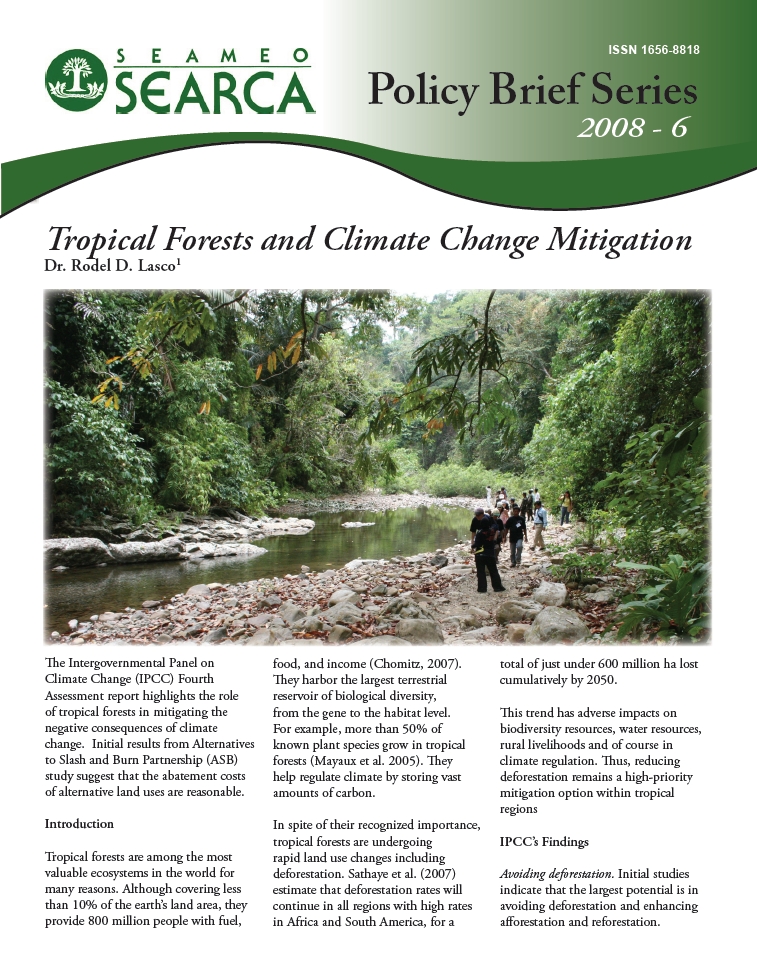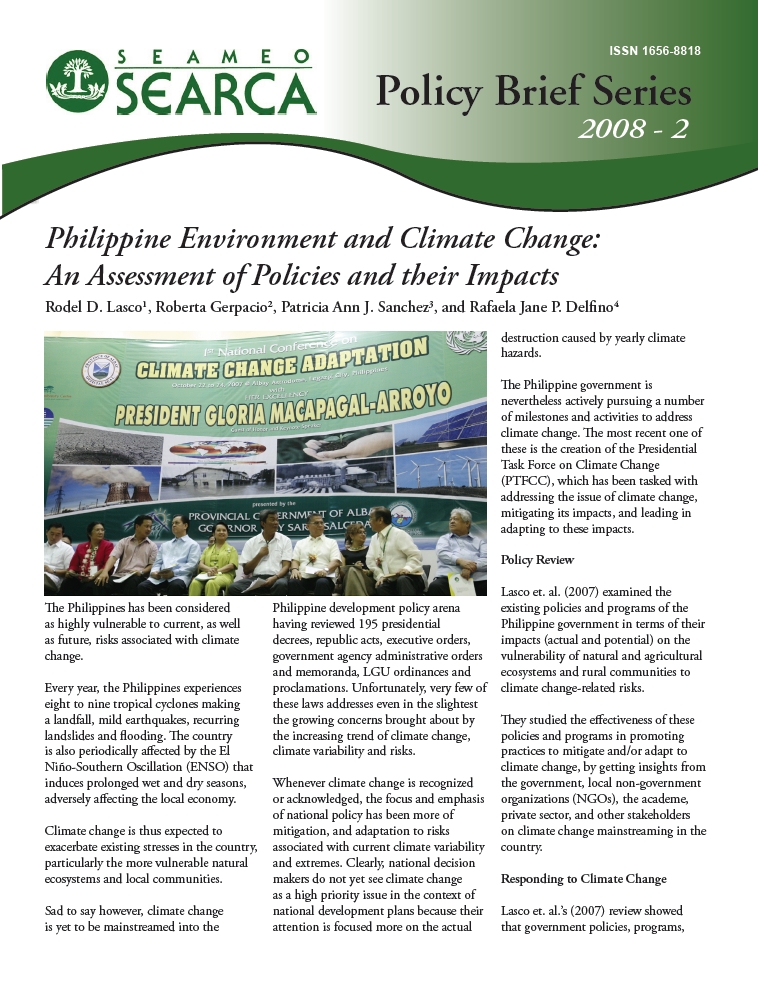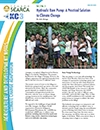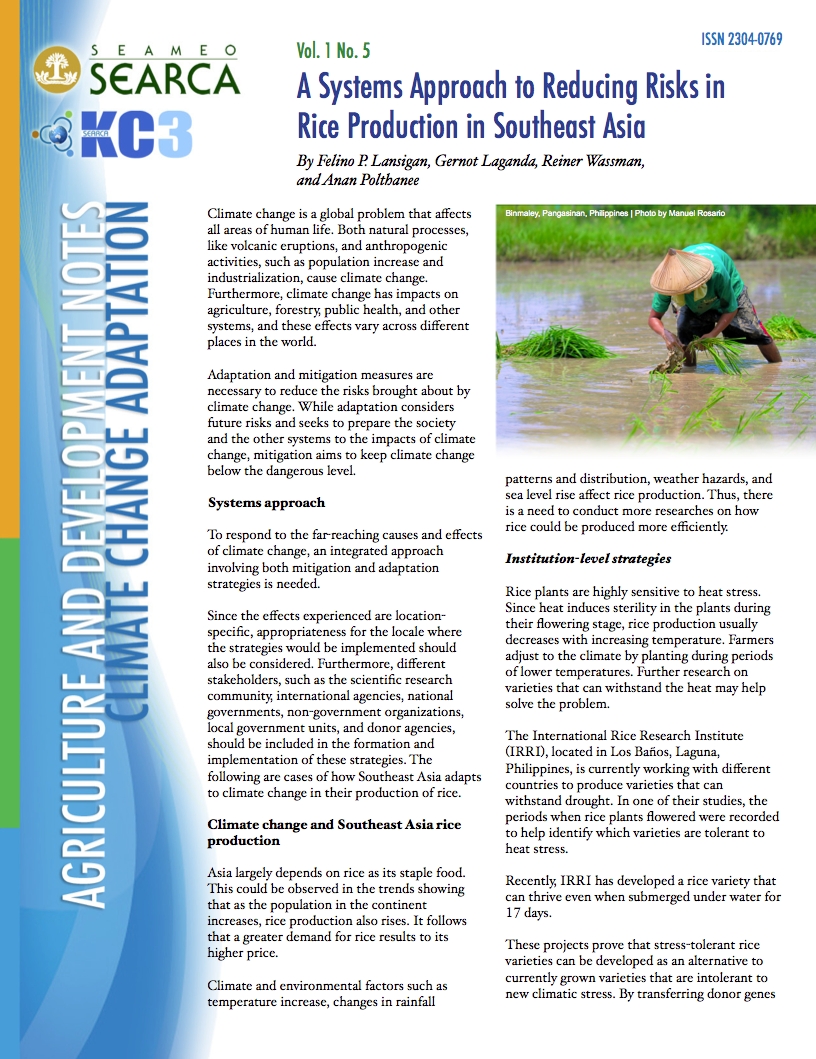SEARCA Publications
Tropical forests are among the most valuable ecosystems in the world for many reasons. Although covering less than 10% of the earth’s land area, they provide 800 million people with fuel, food, and income (Chomitz 2007). They harbor the largest terrestrial reservoir of biological diversity, from the gene to the habitat level. For example, more than 50% of known plant species grow in tropical forests (Mayaux et al. 2005). They help regulate climate by storing vast amounts of carbon. In…
The Philippines has been considered as highly vulnerable to current, as well as future, risks associated with climate change. Every year, the Philippines experiences eight to nine tropical cyclones making a landfall, mild earthquakes, recurring landslides and flooding. The country is also periodically affected by the El Niño-Southern Oscillation (ENSO) that induces prolonged wet and dry seasons, adversely affecting the local economy. Climate change is thus expected to exacerbate existing stresses in the country, particularly the more vulnerable natural ecosystems…
In the face of the threats posed by climate change, initiatives for the conservation of natural resources are now being prioritized globally, particularly the conservation of watersheds and forests to reduce carbon emissions. REDD+ (Reducing Emissions, Deforestation, and Forest Degradation and the Conservation of Existing Carbon Stocks) is now gaining ground as a sound mechanism to address climate change. However, countries need to mainstream and adequately implement the social, governance, and environmental safeguards of REDD+ for the mechanism to succeed.…
Watershed is critical to economic development and environmental protection in Southeast Asia. Thus, managing them effectively is key in the pursuit of sustainable development. Watershed management, however, is a complex decision-making process. The threat brought by climate change further puts stress on the already-stressed watersheds in the region, and would further complicate the already-complex process of watershed management and governance. Extensive research is therefore needed to provide an empirical database that will predict the future changes in watersheds. An integrated…
Anangue is an upland village located in Murcia, Negros Occidental, Philippines. The primary livelihood in the village is farming. However, the villagers experience low agricultural productivity due to the lack of access to sufficient water. The nearest source of water in the village is a freshwater spring located 240 meters away and elevated by 80 meters. Thus, the community greatly depends on rainfall for domestic consumption and agricultural production. However, with the onset of climate change causing variations in the…
Flooding is a prevalent problem in the Philippines, especially now that there are heavier rains due to climate change. Experience has shown that being prepared for a disaster can minimize casualty and damage. However, for people living in remote areas, preparedness could be a problem, as they do not usually have access to radio, TV, mobile phones, and other media that can immediately warn of possible floods and landslides. As such, an effective early warning system needs to be designed…
Climate change is a global problem that affects all areas of human life. Both natural processes, like volcanic eruptions, and anthropogenic activities, such as population increase and industrialization, cause climate change. Furthermore, climate change has impacts on agriculture, forestry, public health, and other systems, and these effects vary across different places in the world. Adaptation and mitigation measures are necessary to reduce the risks brought about by climate change. While adaptation considers future risks and seeks to prepare the…
Southeast Asia relies heavily on its agricultural capacity, species diversity, and natural resources. However, with the whole region experiencing the impacts of climate change, the need to identify strategic roles for climate change adaptation and mitigation in Southeast Asia rises. Therefore, initiatives, policies, and new technologies are needed to help different countries in the region manage the effects of climate change. The challenge is in contextualizing and localizing international policies in designing and implementing projects on climate change adaptation and…
Albay, Philippines is a province located along the eastern coast of the country, facing the Philippine Sea and the Pacific Ocean. With a land area of 2, 552 square kilometres, it is considered the second largest in the Bicol Region. Aside from being the second largest province in the region, Albay is also known as the “Vatican of Disasters” of the Philippines. Various natural phenomena such as typhoons, landslides, volcanic eruptions, and tsunamis have plagued the area. As a…
Dumangas, Iloilo is a coastal town located in the island of Panay, Visayas, Philippines with most of its area devoted to agriculture and fisheries. However, the town experiences two extreme conditions: drought during the dry season, and flooding during the rainy season—where for the latter, 65% of the total area of Dumangas is usually inundated. Consequently, farmers experience difficulty in monitoring and maintaining their crops. As the local government’s initial step to help the farmers adjust to the adverse…























